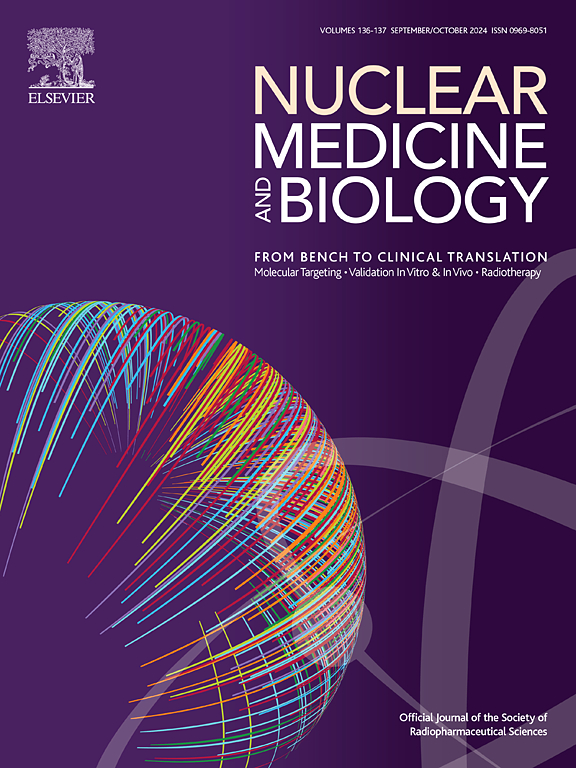Radiolabeling yield dependency of post-dry distillation decay of astatine-211
IF 3.6
4区 医学
Q1 RADIOLOGY, NUCLEAR MEDICINE & MEDICAL IMAGING
引用次数: 0
Abstract
Aim/introduction
Astatine-211 (211At) is one of the most promising nuclides for targeted alpha therapy. However, while several clinical trials are ongoing worldwide, some aspects of the element remain unexplored. This work aims to investigate changes in radiochemical yield over time, expressed as the number of 211At decays, post-dry distillation using two common astatination reactions.
Materials and methods
211At was purified from activated bismuth targets via dry distillation and eluted in chloroform. The solvated activity was then either evaporated to dryness or left in the chloroform eluate. Before chemical reactions, both forms of the starting material were allowed to age at room temperature for up to 28 h, correlating to 3 ∙ 1012 211At decays. All chemical reactions were subsequently started from a dry residue. Radiolabeling was carried out either via electrophilic destannylation of tri(methyl)phenylstannane, or via the nucleophilic substitution of bis(4-tert-butylphenyl)iodonium p-toluenesulfonate. Radiochemical yield was determined using a dual flow radiodetection HPLC method allowing direct yield quantification.
Results
In both cases, where 211At was stored either as a dry residue or in chloroform, radiochemical yields decreased with increasing amounts of radioactive decay. This was true both for nucleophilic and electrophilic astatinations. In the case of 211At stored in chloroform, the dose-yield relationship indicates a more rapid decrease for electrophilic astatination. However, decreases in radiochemical yield could be mitigated by increasing the precursor concentration, keeping yields constant above 80 % even when using 211At after 28 h, corresponding up to 3 ∙ 1012 211At decays. There is also an indication that higher amounts of oxidizing/reducing agents and redissolution of dry 211At in fresh chloroform may mitigate the loss in yield to some extent.
Conclusion
Radiochemical yields in labeling with 211At decrease over time post dry distillation independent if the 211At was kept dry or in chloroform. If high specific activity is a requirement for the final radiolabeled product, the most reliable way to maintain high yields is to perform the radiolabeling close in time after the dry distillation.

砹-211干馏后衰变的放射性标记产率依赖性
astatine -211 (2111at)是靶向α治疗中最有前途的核素之一。然而,尽管一些临床试验正在世界范围内进行,但该元素的某些方面仍未被探索。这项工作的目的是研究放射性化学产率随时间的变化,表示为2111at衰变的数量,干馏后使用两种常见的砹反应。材料与方法用干馏法从活化铋靶中纯化出at,并用氯仿洗脱。然后将溶剂化活性蒸发至干燥或留在氯仿洗脱液中。在化学反应之前,两种形式的起始材料都被允许在室温下老化长达28小时,对应于3∙1012 2111at衰变。所有的化学反应都是从干燥的残渣开始的。放射性标记要么通过三(甲基)苯基锡烷的亲电去氨化,要么通过双(4-叔丁基苯基)碘对甲苯磺酸的亲核取代进行。放射化学产率采用双流放射检测高效液相色谱法测定,允许直接定量产率。结果在这两种情况下,21at作为干残留物或在氯仿中储存,放射化学产量随放射性衰变量的增加而下降。这对亲核和亲电原子凝聚都是成立的。对于储存在氯仿中的21at,剂量-产率关系表明亲电性失稳的下降速度更快。然而,可以通过增加前体浓度来缓解放射化学产率的下降,即使在使用2111at 28 h后,产率也保持在80%以上,对应于3∙1012个2111at衰变。也有迹象表明,在新鲜氯仿中加入更多的氧化/还原剂和干的2111at再溶解可能在一定程度上减轻产量损失。结论在干馏后用2111at标记放射化学产率随时间降低,与2111at保持干燥或氯仿无关。如果对最终放射性标记产品有高比活度的要求,保持高收率的最可靠方法是在干馏后及时进行放射性标记。
本文章由计算机程序翻译,如有差异,请以英文原文为准。
求助全文
约1分钟内获得全文
求助全文
来源期刊

Nuclear medicine and biology
医学-核医学
CiteScore
6.00
自引率
9.70%
发文量
479
审稿时长
51 days
期刊介绍:
Nuclear Medicine and Biology publishes original research addressing all aspects of radiopharmaceutical science: synthesis, in vitro and ex vivo studies, in vivo biodistribution by dissection or imaging, radiopharmacology, radiopharmacy, and translational clinical studies of new targeted radiotracers. The importance of the target to an unmet clinical need should be the first consideration. If the synthesis of a new radiopharmaceutical is submitted without in vitro or in vivo data, then the uniqueness of the chemistry must be emphasized.
These multidisciplinary studies should validate the mechanism of localization whether the probe is based on binding to a receptor, enzyme, tumor antigen, or another well-defined target. The studies should be aimed at evaluating how the chemical and radiopharmaceutical properties affect pharmacokinetics, pharmacodynamics, or therapeutic efficacy. Ideally, the study would address the sensitivity of the probe to changes in disease or treatment, although studies validating mechanism alone are acceptable. Radiopharmacy practice, addressing the issues of preparation, automation, quality control, dispensing, and regulations applicable to qualification and administration of radiopharmaceuticals to humans, is an important aspect of the developmental process, but only if the study has a significant impact on the field.
Contributions on the subject of therapeutic radiopharmaceuticals also are appropriate provided that the specificity of labeled compound localization and therapeutic effect have been addressed.
 求助内容:
求助内容: 应助结果提醒方式:
应助结果提醒方式:


